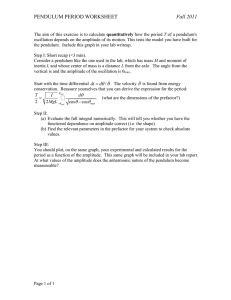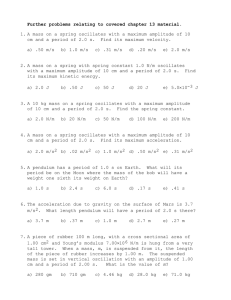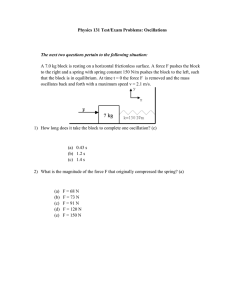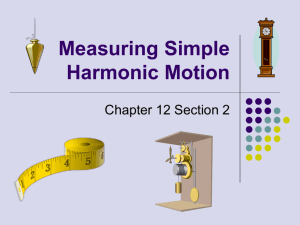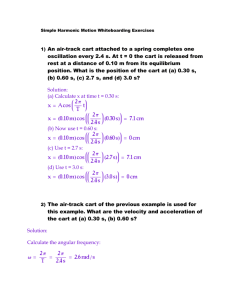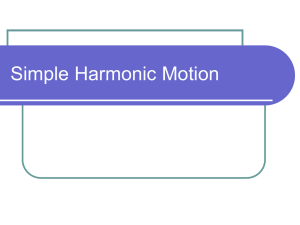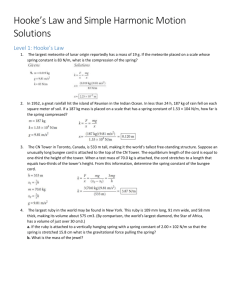Solutions for HW #14
advertisement
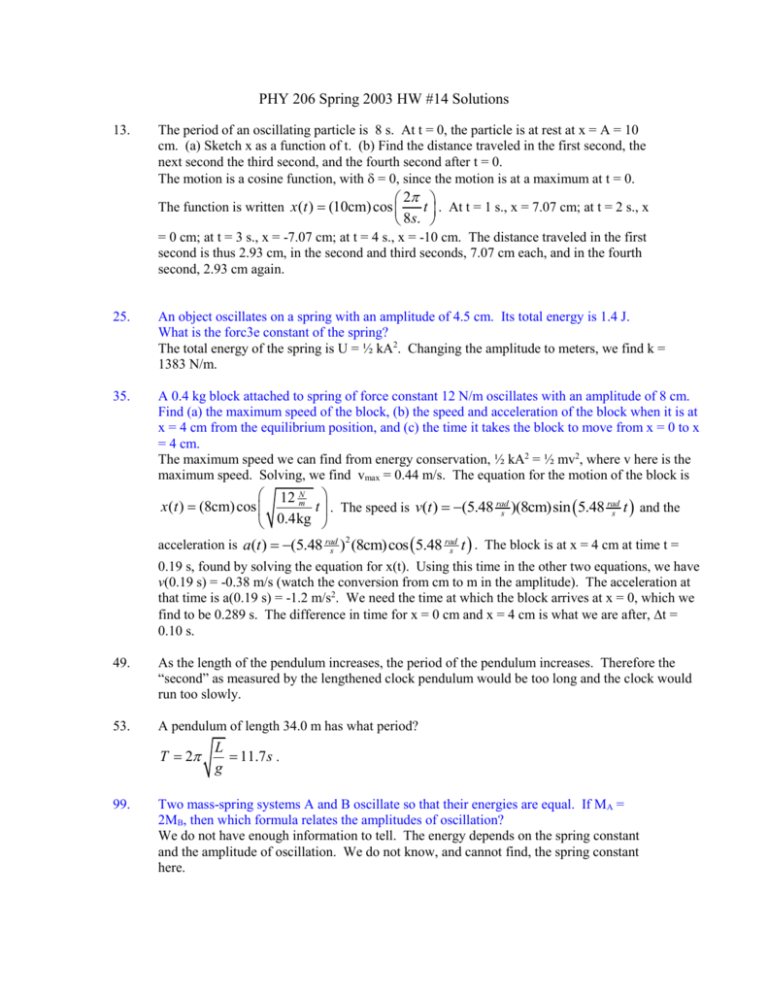
PHY 206 Spring 2003 HW #14 Solutions 13. The period of an oscillating particle is 8 s. At t = 0, the particle is at rest at x = A = 10 cm. (a) Sketch x as a function of t. (b) Find the distance traveled in the first second, the next second the third second, and the fourth second after t = 0. The motion is a cosine function, with = 0, since the motion is at a maximum at t = 0. 2 t . At t = 1 s., x = 7.07 cm; at t = 2 s., x 8s. The function is written x (t ) (10cm) cos = 0 cm; at t = 3 s., x = -7.07 cm; at t = 4 s., x = -10 cm. The distance traveled in the first second is thus 2.93 cm, in the second and third seconds, 7.07 cm each, and in the fourth second, 2.93 cm again. 25. An object oscillates on a spring with an amplitude of 4.5 cm. Its total energy is 1.4 J. What is the forc3e constant of the spring? The total energy of the spring is U = ½ kA2. Changing the amplitude to meters, we find k = 1383 N/m. 35. A 0.4 kg block attached to spring of force constant 12 N/m oscillates with an amplitude of 8 cm. Find (a) the maximum speed of the block, (b) the speed and acceleration of the block when it is at x = 4 cm from the equilibrium position, and (c) the time it takes the block to move from x = 0 to x = 4 cm. The maximum speed we can find from energy conservation, ½ kA2 = ½ mv2, where v here is the maximum speed. Solving, we find vmax = 0.44 m/s. The equation for the motion of the block is 12 Nm rad x (t ) (8cm) cos t . The speed is v(t ) (5.48 rad s )(8cm)sin 5.48 s t and the 0.4kg 2 rad acceleration is a(t ) (5.48 rad s ) (8cm)cos 5.48 s t . The block is at x = 4 cm at time t = 0.19 s, found by solving the equation for x(t). Using this time in the other two equations, we have v(0.19 s) = -0.38 m/s (watch the conversion from cm to m in the amplitude). The acceleration at that time is a(0.19 s) = -1.2 m/s2. We need the time at which the block arrives at x = 0, which we find to be 0.289 s. The difference in time for x = 0 cm and x = 4 cm is what we are after, t = 0.10 s. 49. As the length of the pendulum increases, the period of the pendulum increases. Therefore the “second” as measured by the lengthened clock pendulum would be too long and the clock would run too slowly. 53. A pendulum of length 34.0 m has what period? T 2 99. L 11.7 s . g Two mass-spring systems A and B oscillate so that their energies are equal. If MA = 2MB, then which formula relates the amplitudes of oscillation? We do not have enough information to tell. The energy depends on the spring constant and the amplitude of oscillation. We do not know, and cannot find, the spring constant here. 101. Pendulum A has a bob of mass MA and length LA, while pendulum B has a mass MB and length LB. If the period of A is twice that of B, then (c) LA = 4LB , whatever the mass ratio. 104. An object on a horizontal spring oscillates with a period of 4.5 s. If the object is suspended from the spring vertically, by how much is the spring stretched from its natural length when the object is in equilibrium? 2 m T m The period is given by T 2 , so we have . When hanging vertically, k 2 k m the forces balance at equilibrium, so we have mg ky0 y0 g . Combining the k two results we find y0 = 5.03 m. 109. A cube with side a floats on water. Find the period of oscillation if the cube is pushed down slightly and then released. The buoyant force at equilibrium is FB Vg a 2 yg where y is the amount of the wooden block under water. Increasing this by an amount y leads to a restoring force F a 2 g y . This is then equal to ma, so by comparing the equations with those of the spring motion, we effectively have a “k” here which is a2g. Thus, the oscillation period must be T 2 m . a2g
